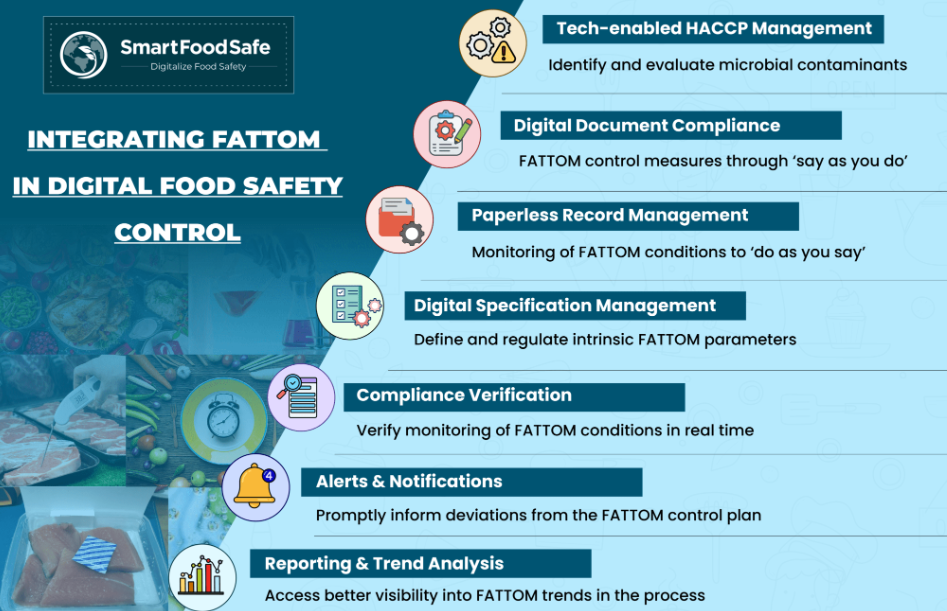
FATTOM is an acronym used in the field of food safety and microbiology to represent the key elements that influence the growth and survival of microorganisms in food. Food ingredients, work-in-progress materials, finished food products, and the typical environment of food-related businesses create ideal circumstances for the proliferation of detrimental bacteria and other pathogens associated with foodborne illnesses. As the prominence of digital food safety management systems rises due to their ability to offer greater visibility, accuracy, efficiency, and transparency in food safety practices, their adoption, integrated with features to ease the monitoring and control of FATTOM components, becomes essential for food businesses in an increasingly interconnected and tech-enabled world.
F – Food
This element signifies that microorganisms utilize food substances as their nourishment source for development. Similar to humans, microorganisms also rely on the nutrients found in food for their sustenance. Various food items contain a wealth of nutrients that provide a suitable environment for microorganisms to grow.
Microorganisms naturally exist in food products. Through preparation, pre-treatment, and cooking, the presence of potentially harmful bacteria in foods can be minimized, rendering them safe for consumption.
A- Acidity
Bacteria thrive in slightly acidic to neutral environments (pH 4.6-7.5), with the optimal growth range being 6.6 to 7.5. According to Food and Drug Administration (FDA) regulation, “acidified foods shall be so manufactured, processed, and packaged that a finished equilibrium pH value of 4.6 or lower is achieved within the time designated in the scheduled process and maintained in all finished foods”.
Food acidity influences which foodborne pathogen is likely. Microorganisms vary in pH preferences for growth. This factor is crucial in the food industry to manage food poisoning bacteria growth and food quality alteration. Acidity control is a core principle in using fermentation for food preservation. When dealing with low-acid foods, enhance their acidity before canning, thoroughly cook low-acid foods, precisely gauge food pH using pH strips or a pH meter, and use appropriate organic acids by following the permissible acid limits.
T- Temperature
This component pertains to the degree of heat that food is subjected to, regarding both storage and cooking temperatures. Temperature plays a pivotal role in influencing microbial activity within food as pathogenic microorganisms find their optimal growth conditions in the range of room temperature and the temperature danger zone, spanning from 40°F to 140°F (5°C to 60°C).
Effective microbial inactivation via in-depth temperature management within the realms of food service, retail, and production can include:
Cooking
Hot holding and cold holding
Refrigeration and freezing
Thawing
It is also imperative to ensure that high-risk perishable foods do not remain within the temperature danger zone for over 2 hours; otherwise, disposal is recommended. Regulating storage temperatures for a specified duration also diminishes the probability of foodborne pathogen proliferation in food.
T- Time
Microorganisms require time to multiply. Although the presence of a small number of bacteria typically entails a low risk, prolonged exposure under suitable conditions allows for their multiplication, increasing the contamination risk. High-risk foods should not stay within the temperature danger zone for more than 4 hours. The extended presence of any food in this temperature range heightens the likelihood of bacterial impact on the product.
Within a food industry context, both ingredients and finalized products must consistently inhabit conditions unsuitable for microorganisms. Thorough vigilance is essential in monitoring foods and their storage settings to guarantee their safety and quality. Even foods housed in areas for hot or cold holding possess a maximum time limit for public display. Recommended heating durations for cooking or reheating food and regularly supervising product shelf-life to guarantee the use of fresh and safe ingredients should be followed.
O – Oxygen
Microorganisms can be categorized as either aerobic or anaerobic. Aerobic microorganisms rely on oxygen for survival, while anaerobic microorganisms perish in its presence.
A prominent mode of oxygen control in food production or service settings is the vacuum-sealing of food. By extracting oxygen from the packaging, vacuum-sealed items are projected to exhibit extended shelf life. Another method to restrict oxygen interaction with foods involves utilizing airtight containers for storage. When sealed and stored in a refrigerator, these foods are less susceptible to contamination. Further methods to counter oxygen presence in foods include the utilization of oxygen scavengers, which effectively absorb oxygen within sealed containers.
M- Moisture
Food manufacturers often advise consumers to "store in a cool, dry place" to prevent foods from absorbing moisture, which can make them more susceptible to contamination. Pathogens thrive in high-moisture environments, and a food's susceptibility to spoilage is closely linked to its moisture content and water activity. Lower moisture content generally leads to better shelf stability and reduced microbial spoilage risk. Water activity (aw) gauges the available water and is quantified on a scale from 0 to 1.0. Bacteria, yeast, and molds experience rapid multiplication in environments with high water activity levels surpassing 0.86.
Strategies for moisture control include managing air circulation, using hermetic containers moisture absorbers, and maintaining dry food production environments to deter harmful microorganisms.
As the integration of advanced technologies has led to the evolution of innovative approaches in food safety management, Smart Food Safe continuously aspires to stay at the forefront by leveraging digital modules capable of keeping FATTOM components in check. Their Smart HACCP automates hazard identification and evaluation, optimizing Risk Assessment, Hazard Analysis, Hazard Database, and Hazard Control Plan execution. Smart Docs streamline policy procedures through the implementation of digital document compliance, ensuring clarity and compliance. Smart Record offers real-time monitoring, prompt detection of process deviations, and remediation strategies through convenient paperless record management. Smart Specification defines precise food safety parameters, such as pH, acidity, moisture, and water activity, enhancing microbial risk anticipation. Smart Compliance digitalizes product release processes and verifies compliance, boosting the food safety framework’s efficacy and integrity. Hence, Smart Food Safe represents a paradigm shift in controlling FATTOM components with a holistic digital outlook.
_1.png)